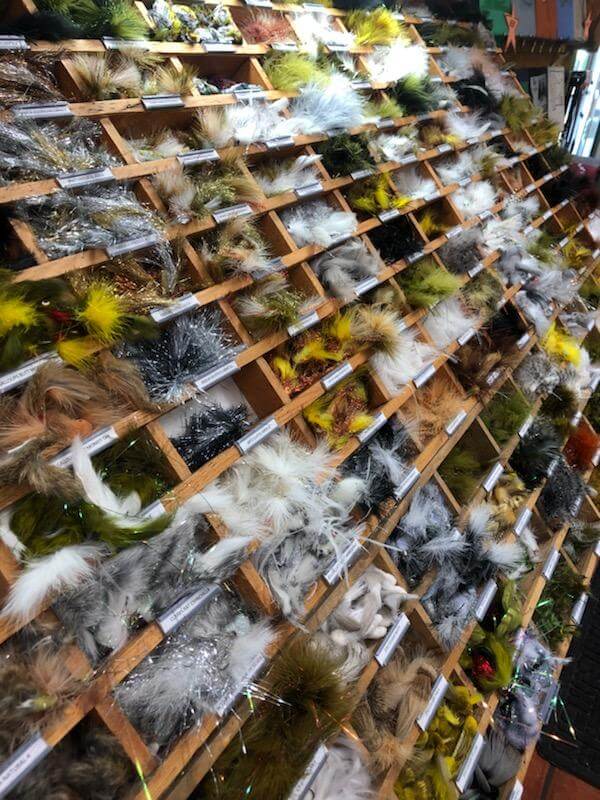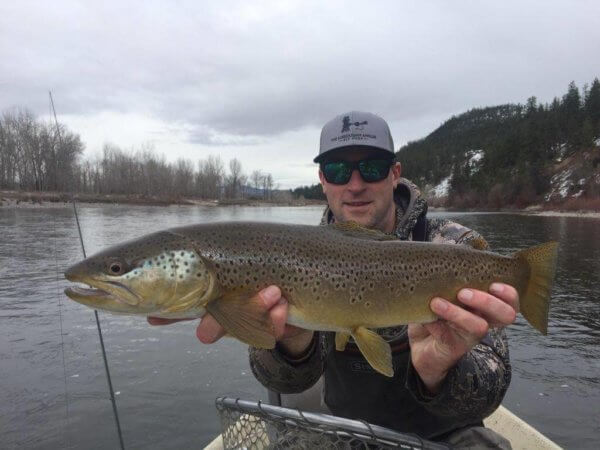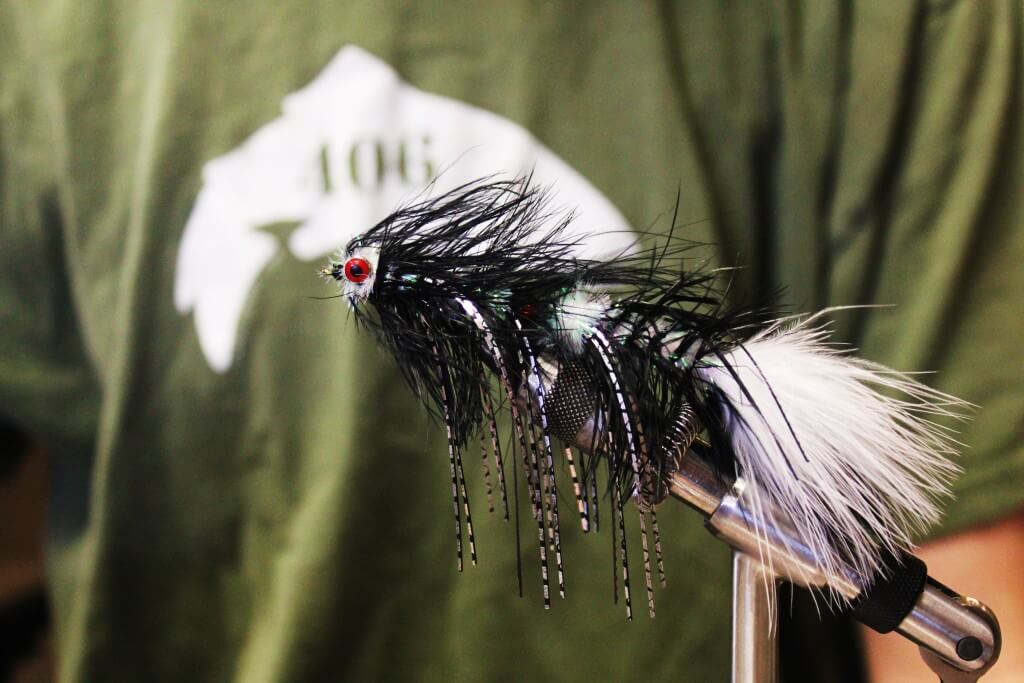The first rule of piscatorial predation. Big Fish eat Little Fish. The first rule of Missoula’s Piscatorial Predators. Big Streamers catch big fish!
There’s never a wrong time to throw a streamer. Unlike grasshoppers or Salmon flies, which appear at specific times, small fish are available to larger fish 365 days a year. There are many winter streamer fishermen in our area, and while they may not catch as many fish as a cold weather nympher, total weight may be a close contest. When the weather breaks in March, smaller fish migrate to the warmer shallows. The big fish take advantage of this migration and streamer fishing rocks. Rising and falling river flows surrounding run-off also kicks off excellent streamer fishing. Flow change displaces all fish, and big fish take advantage of disoriented smaller fish seeking new homes. The streamer fishing will be strong through mid July, and then it tapers back to normal.

The Missoulian Angler Fly Shop has the largest selection of streamers in Missoula, for very good reason. We have streamers for all water and all line weights. The big articulated streamers, like the Articulated Kreelex, need a 7 or 8 weight to effectively handle them. We have highly weighted streamers, like the Sculpizilla, for use with floating lines. And we have a large selection of Galloup’s neutrally buoyant streamers (Butt Monkey, Tips Up) that work best with a sink tip 7 or 8 weight.
We also carry a wide variety of flies handled with a 5 or 6 weight like the Clarks Rat. These are by necessity lighter and smaller than their grown up cousins, but still move big fish. From a biological standpoint, it’s conventional wisdom most fish will not attack anything that’s bigger than 1/3 it’s size. So if you fish a 3 inch streamer, you can expect to catch nothing smaller than a 9” fish. Put on a 5” streamer, and now you’ve weeded out all the fish below 15”. This is one reason some anglers feel streamers are less effective, because a dry fly angler or nympher makes his living on 8-13” fish. (Hey, just being honest) Tie on a big streamer, and 80% of the river’s trout population is now untargeted. No wonder streamer fishing can feel slow, when so many fish aren’t even in the mix.

When choosing your fly, line weight isn’t the only factor. In late June, when the water is high, the size of your streamer doesn’t really matter. Even if it hits the water with a thud, the big water masks it’s landing. But throw that same fly in late August, and it will move fish- all away from you! Skinny waters need skinnier, low impact streamers. Especially if you’re wading. Streamer fishing is the most intrusive form of fly fishing, with dry flies being the least intrusive and nymphs falling in between. If you’re fishing a spot with limited wading opportunities, run your dries first, then a nymph, then streamers. Because if you rip a big streamer through the pool first, the fish may not be as amenable to rising after that! In a boat, it’s not that critical. You’re always moving to new fish, so it’s not important how you attack specific spots. You’re just going to move on! You can also fish a bigger fly in skinnier water, because the splash will be in one spot, and the streamer will be fished in another.
We’re big fans of fluorocarbon for streamer fishing. We all know Fluorocarbon is invisible in water, but it’s also much heavier than standard leader material. On a sink tip, a 3’ leader of 10 pound fluoro keeps the fly down at the level of the sink tip. With a floating line, a full Fluorocarbon leader helps the fly gain a little more depth. Invisibility is just an added bonus, it’s the higher specific gravity that’s more important.

We have enough streamers that it can sometimes be a bit of an adventure filling your fly box! We recommend, when getting started in this, following this old adage. Light day, light fly- Dark day, dark fly- Bright day, bright fly. With that in mind, make sure to vary your fly size, always remembering what line weight you’ll be using. If you use sink tips, weight won’t be critical. Floating lines might require you to look for flies with a little weight on them, like a conehead or smaller dumbbell eyes. One of our favorite weighted flies is the Sculpzilla. Others are the Skullhead Super Tinsel and the Baby Gonga. These flies can be thrown on a 5 weight with some concentration, and larger rods handle them with ease.
Classic streamer fishing while wading utilizes a cast quartering downstream. Fish the cast out, and then take 3 steps and do it again. We would amend that to consider water clarity. In stained water, you may only take one step. In clear water, you may take four steps. What you’re trying to do is give every fish within casting range a chance to see your fly, without throwing over stale fish. From a boat, the classic streamer technique is hammer the bank, the closer the better most of the time. But keep your eyes open for mid river structure like rootballs and boulders. These hold fish as well. Don’t neglect the riffles. Two feet of moving water holds more big fish than you think, and are well worth running a streamer through.
No matter where you’re fishing or what your fishing for, listen to the fish. They’ll tell you what they want, and how to present it. We often start with a very gentle stripping action, but if that doesn’t move fish, we get continuously more aggressive until we’re stripping with the line hand and pushing the rod forward with the other, moving the fly as fast as possible! Don’t worry. If a trout wants your fly, you CANNOT strip it faster than the trout can swim. Varying your retrieve allows the trout to respond to the action it prefers.

There are three types of strikes to a streamer. The type A strike is a killing strike. The trout is eating, and your streamer is dead. You almost can’t miss this type of strike. The Type B strike is the action of a fish defending its territory from an invasive presence. The trout will lash out and chase the intruder away, but is not as interested in feeding, and you may not gat a take to this movement. The Type C strike is asimple curiosity. The trout will follow the streamer out, slowly, making making light nips on the tail in an effort to find out what this thing is. This fish is not actively feeding, and may be enticed to strike, but it’s definitely not a given.
From a boat, the Blackfoot River may be the best streamer river in our area. Strewn with boulders, and a gradient that keeps the water moving, the Blackfoot is streamer paradise. Lots of places to hide, and your fly is moving fast enough that fish don’t get a long time to look at it. Rock Creek holds awesome streamer fishing for the wading angler, because its smaller size allows working both sides of the river. Smaller streamers, like the Sparkle Minnow, are often more effective on Rock Creek, due to the average size of the fish.

As an aside, yellow streamers seem to be a clarion call to the Northern Pike Minnow. So while trout are also attracted to yellow, you will see way more than your share of the NPM if you go lots of yellow. A black streamer seems to perform all the time, as does white in our area. Special mention should be made of the Kreelix. Made from Kreinik sparkle material, this bright fly pulls fish out of places they don’t normally leave. All of our staff and guides are streamer junkies, so if this has raised any questions, call 406-728-7766 or email [email protected] for more information!




